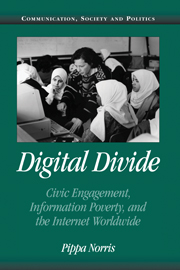Book contents
- Frontmatter
- Contents
- List of Tables
- List of Figures
- Preface
- PART I INTRODUCTORY FRAMEWORK
- 1 The Digital Divide
- 2 Understanding the Digital Divide
- 3 Wired World
- 4 Social Inequalities
- PART II THE VIRTUAL POLITICAL SYSTEM
- PART III THE DEMOCRATIC DIVIDE
- Appendix A Nations in the Study and Abbreviated Names Used in Figures
- Notes
- Select Bibliography
- Index
3 - Wired World
Published online by Cambridge University Press: 05 June 2012
- Frontmatter
- Contents
- List of Tables
- List of Figures
- Preface
- PART I INTRODUCTORY FRAMEWORK
- 1 The Digital Divide
- 2 Understanding the Digital Divide
- 3 Wired World
- 4 Social Inequalities
- PART II THE VIRTUAL POLITICAL SYSTEM
- PART III THE DEMOCRATIC DIVIDE
- Appendix A Nations in the Study and Abbreviated Names Used in Figures
- Notes
- Select Bibliography
- Index
Summary
The World Bank, the United Nations, and the G-8 have expressed alarm that poorer societies lacking technological investment will drift farther behind their wired rivals in the global marketplace, whereas advanced industrialized societies will surge even farther ahead on the back of dramatic productivity gains. Multiple policy initiatives have been proposed, such as investment in technological infrastructure in Malaysia, computer training and education in schools in Latvia, and innovative community-level schemes in Bangladesh. Yet understanding the role of the state and the market in this process, and predicting which initiatives will succeed or fail in widening access in poorer societies, remains difficult unless we understand the reasons for the North–South divide. To unravel this issue we need to map the global spread of the information society and analyze the underlying conditions driving the process of technological transfer. Many studies by historians, development theorists, and communication scholars have attempted to characterize the mechanics of the diffusion process, and economists and marketing specialists have attempted to identify the driving factors behind the demand for new products. Drawing on this literature, after discussing the theoretical debate, this chapter focuses on four interrelated questions:
What is the global pattern of Internet diffusion?
Does this pattern represent the particular characteristics of Internet diffusion per se, or does it reflect similar trends found in the adoption of older forms of info-tech, such as radios, telephones, and televisions? […]
- Type
- Chapter
- Information
- Digital DivideCivic Engagement, Information Poverty, and the Internet Worldwide, pp. 39 - 67Publisher: Cambridge University PressPrint publication year: 2001

